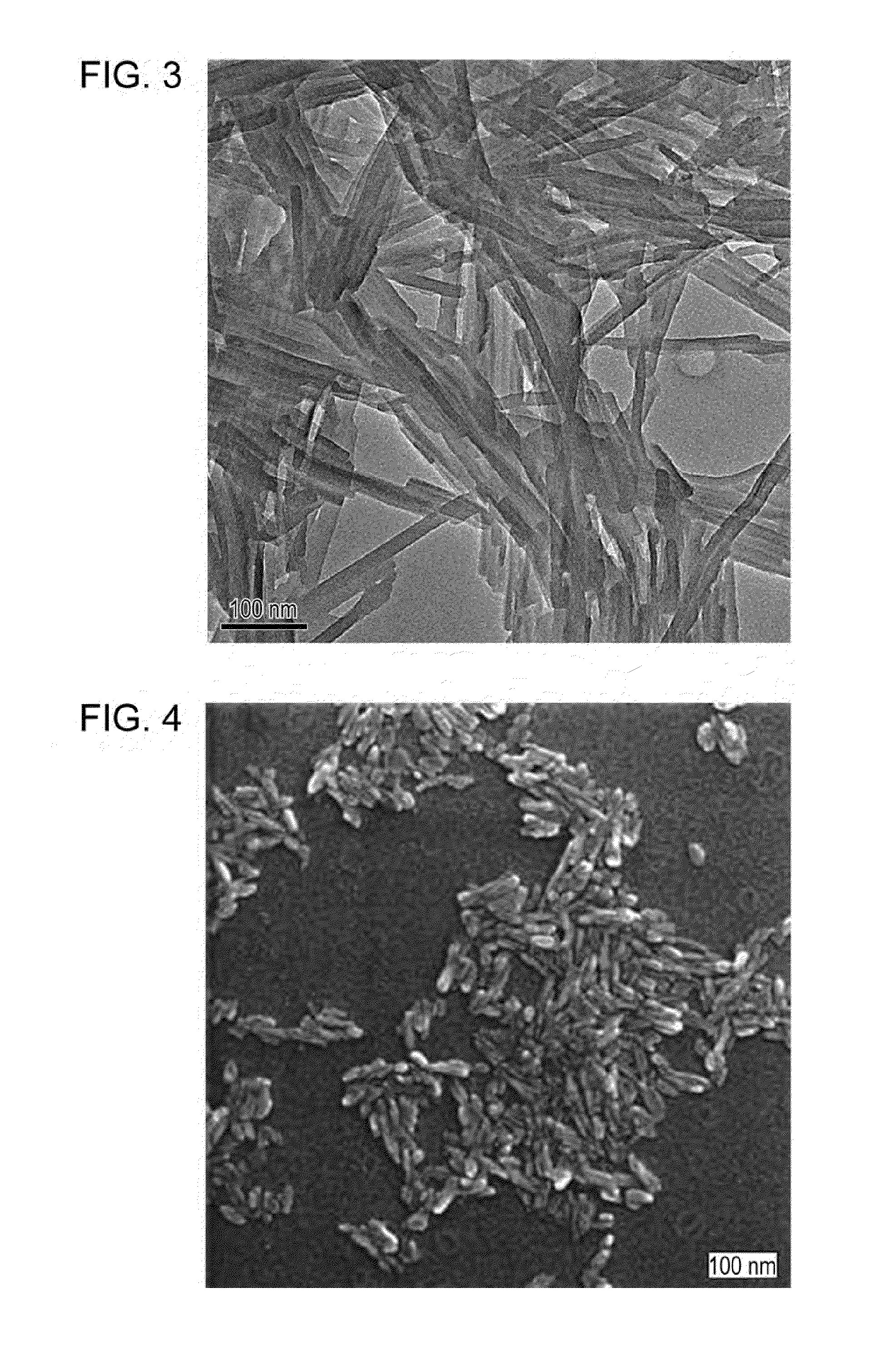Phthalocyanine nanorod and photoelectric conversion device
a technology of photoelectric conversion device and phthalocyanine nanorod, which is applied in the direction of application, final product manufacturing, sustainable manufacturing/processing, etc., can solve the problems of not being able to reach the positive or the negative electrode, not being able to obtain electromotive force, and not being able to extract charges, etc., to achieve higher solvent dispersibility, less likely to fail, and high durability
- Summary
- Abstract
- Description
- Claims
- Application Information
AI Technical Summary
Benefits of technology
Problems solved by technology
Method used
Image
Examples
example 1
Production of Ink Composition (Photoelectric Conversion Device Material)
[0162]Step (a)
[0163]A concentrated sulfuric acid solution was prepared by adding and completely dissolving 1.6 g of copper phthalocyanine (Fastogen Blue 5380E (trade name, manufactured by DIC Corporation)), which is an unsubstituted phthalocyanine, and 1.2 g of a phthalocyanine derivative represented by (Chem. 10), which is a substituted phthalocyanine, in 81 g of concentrated sulfuric acid (manufactured by KANTO CHEMICAL CO., INC.). Subsequently, 730 g of distilled water was poured into a 1000-mL beaker and sufficiently cooled with ice water. The prepared concentrated sulfuric acid solution was then added to the distilled water under stirring to precipitate a composite of the unsubstituted copper phthalocyanine and the copper phthalocyanine derivative represented by (Chem. 10).
[0164]The obtained composite was then collected in the form of a water-containing composite by filtration through filter paper and suffi...
example 2
Production of Photoelectric Conversion Device
[0174]The dispersion liquid (1) (180 mg) obtained in EXAMPLE (1) was mixed with 180 mg of ortho-dichlorobenzene to provide an ink composition (2) (photoelectric conversion device material (2)).
[0175]A photoelectric conversion device (2) was produced as in EXAMPLE (1) except that the photoelectric conversion device material (2) was used instead of the photoelectric conversion device material (1) to form an organic semiconductor layer (electron-donating material layer) stemming from the photoelectric conversion device material (2) as in EXAMPLE (1), and an electron-accepting material layer was formed thereon by spin-coating with 2 wt % PCBM-ortho-dichlorobenzene.
[0176]Evaluation of the photoelectric conversion device was performed as in EXAMPLE 1 except that the photoelectric conversion device (2) was used instead of the photoelectric conversion device (1). As a result, Jsc was 4.25 mA / cm2; Voc was 0.53 V; FF was 0.44; and PCE calculated fr...
example 3
Production of Transistor
[0177]An n-type silicon substrate was prepared and this was used as a gate electrode. The surface layer of this substrate was thermally oxidized to form a gate insulating film composed of silicon oxide. To this film, the ink composition (2) obtained in EXAMPLE (2) was applied by spin-coating to form a semiconductor film (channel region). Source and drain electrodes constituted by gold thin films were formed by patterning a deposited film. Thus, a transistor (3) was produced. The channel length L (gap between source electrode and drain electrode) was 75 μm and the channel width W was 5.0 mm.
[0178]The transistor (3) was evaluated in terms of transistor characteristics. The transistor characteristics were evaluated with a Digital Multimeter (SMU237, manufactured by Keithley Instruments, Inc.) by measuring the current (Id) between the source electrode and the drain electrode under the application of −80 V while the voltage (Vg) applied to the gate electrode was s...
PUM
| Property | Measurement | Unit |
|---|---|---|
| length | aaaaa | aaaaa |
| temperature | aaaaa | aaaaa |
| distance | aaaaa | aaaaa |
Abstract
Description
Claims
Application Information
 Login to View More
Login to View More - R&D
- Intellectual Property
- Life Sciences
- Materials
- Tech Scout
- Unparalleled Data Quality
- Higher Quality Content
- 60% Fewer Hallucinations
Browse by: Latest US Patents, China's latest patents, Technical Efficacy Thesaurus, Application Domain, Technology Topic, Popular Technical Reports.
© 2025 PatSnap. All rights reserved.Legal|Privacy policy|Modern Slavery Act Transparency Statement|Sitemap|About US| Contact US: help@patsnap.com



